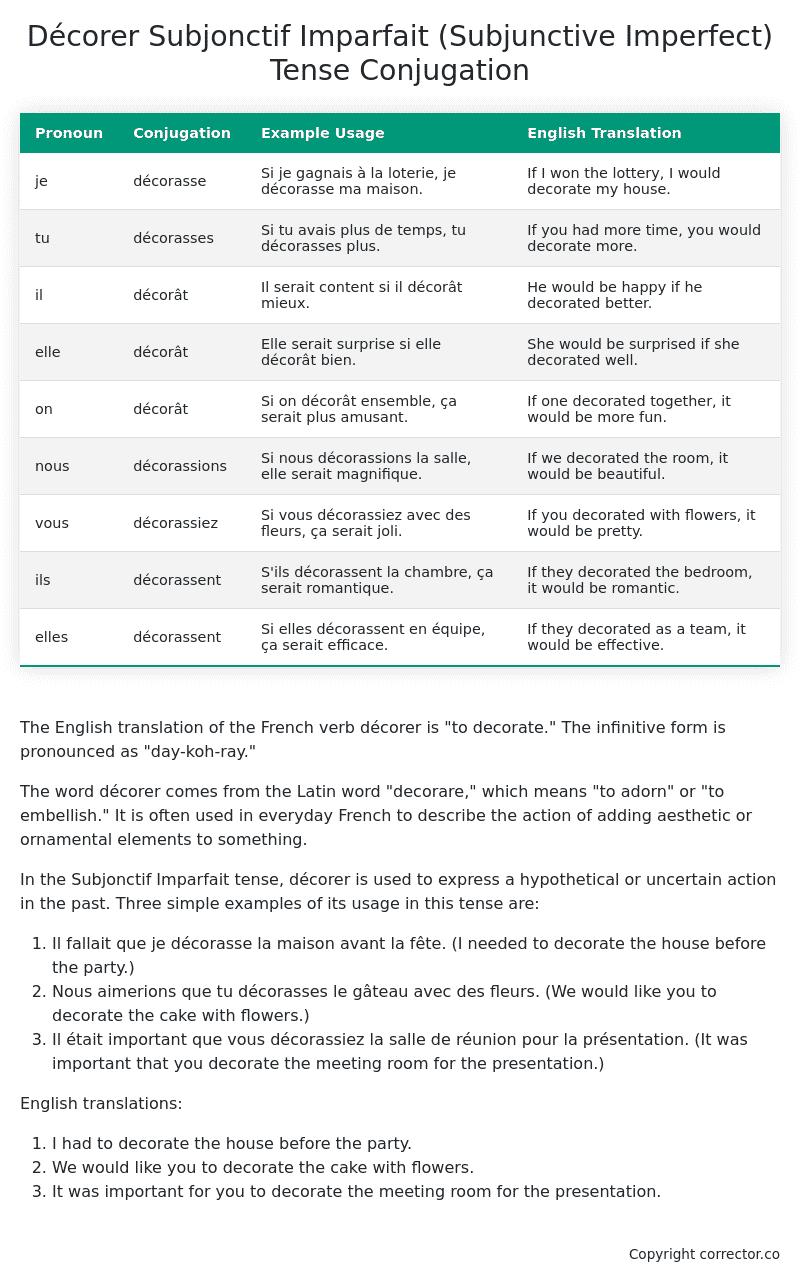Subjonctif Imparfait (Subjunctive Imperfect) Tense Conjugation of the French Verb décorer
Introduction to the verb décorer
The English translation of the French verb décorer is “to decorate.” The infinitive form is pronounced as “day-koh-ray.”
The word décorer comes from the Latin word “decorare,” which means “to adorn” or “to embellish.” It is often used in everyday French to describe the action of adding aesthetic or ornamental elements to something.
In the Subjonctif Imparfait tense, décorer is used to express a hypothetical or uncertain action in the past. Three simple examples of its usage in this tense are:
- Il fallait que je décorasse la maison avant la fête. (I needed to decorate the house before the party.)
- Nous aimerions que tu décorasses le gâteau avec des fleurs. (We would like you to decorate the cake with flowers.)
- Il était important que vous décorassiez la salle de réunion pour la présentation. (It was important that you decorate the meeting room for the presentation.)
English translations:
- I had to decorate the house before the party.
- We would like you to decorate the cake with flowers.
- It was important for you to decorate the meeting room for the presentation.
Table of the Subjonctif Imparfait (Subjunctive Imperfect) Tense Conjugation of décorer
| Pronoun | Conjugation | Example Usage | English Translation |
|---|---|---|---|
| je | décorasse | Si je gagnais à la loterie, je décorasse ma maison. | If I won the lottery, I would decorate my house. |
| tu | décorasses | Si tu avais plus de temps, tu décorasses plus. | If you had more time, you would decorate more. |
| il | décorât | Il serait content si il décorât mieux. | He would be happy if he decorated better. |
| elle | décorât | Elle serait surprise si elle décorât bien. | She would be surprised if she decorated well. |
| on | décorât | Si on décorât ensemble, ça serait plus amusant. | If one decorated together, it would be more fun. |
| nous | décorassions | Si nous décorassions la salle, elle serait magnifique. | If we decorated the room, it would be beautiful. |
| vous | décorassiez | Si vous décorassiez avec des fleurs, ça serait joli. | If you decorated with flowers, it would be pretty. |
| ils | décorassent | S’ils décorassent la chambre, ça serait romantique. | If they decorated the bedroom, it would be romantic. |
| elles | décorassent | Si elles décorassent en équipe, ça serait efficace. | If they decorated as a team, it would be effective. |
Other Conjugations for Décorer.
Le Present (Present Tense) Conjugation of the French Verb décorer
Imparfait (Imperfect) Tense Conjugation of the French Verb décorer
Passé Simple (Simple Past) Tense Conjugation of the French Verb décorer
Passé Composé (Present Perfect) Tense Conjugation of the French Verb décorer
Futur Simple (Simple Future) Tense Conjugation of the French Verb décorer
Futur Proche (Near Future) Tense Conjugation of the French Verb décorer
Plus-que-parfait (Pluperfect) Tense Conjugation of the French Verb décorer
Passé Antérieur (Past Anterior) Tense Conjugation of the French Verb décorer
Futur Antérieur (Future Anterior) Tense Conjugation of the French Verb décorer
Subjonctif Présent (Subjunctive Present) Tense Conjugation of the French Verb décorer
Subjonctif Passé (Subjunctive Past) Tense Conjugation of the French Verb décorer
Subjonctif Imparfait (Subjunctive Imperfect) Tense Conjugation of the French Verb décorer (this article)
Subjonctif Plus-que-parfait (Subjunctive Pluperfect) Tense Conjugation of the French Verb décorer
Conditionnel Présent (Conditional Present) Tense Conjugation of the French Verb décorer
Conditionnel Passé (Conditional Past) Tense Conjugation of the French Verb décorer
L’impératif Présent (Imperative Present) Tense Conjugation of the French Verb décorer
L’infinitif Présent (Infinitive Present) Tense Conjugation of the French Verb décorer
Struggling with French verbs or the language in general? Why not use our free French Grammar Checker – no registration required!
Get a FREE Download Study Sheet of this Conjugation 🔥
Simply right click the image below, click “save image” and get your free reference for the décorer Subjonctif Imparfait tense conjugation!

Décorer – About the French Subjonctif Imparfait (Subjunctive Imperfect) Tense
Formation
Common Everyday Usage Patterns
Interactions with Other Tenses
Subjonctif Présent
Indicatif Passé Composé
Conditional
Conditional Perfect
Summary
I hope you enjoyed this article on the verb décorer. Still in a learning mood? Check out another TOTALLY random French verb conjugation!


